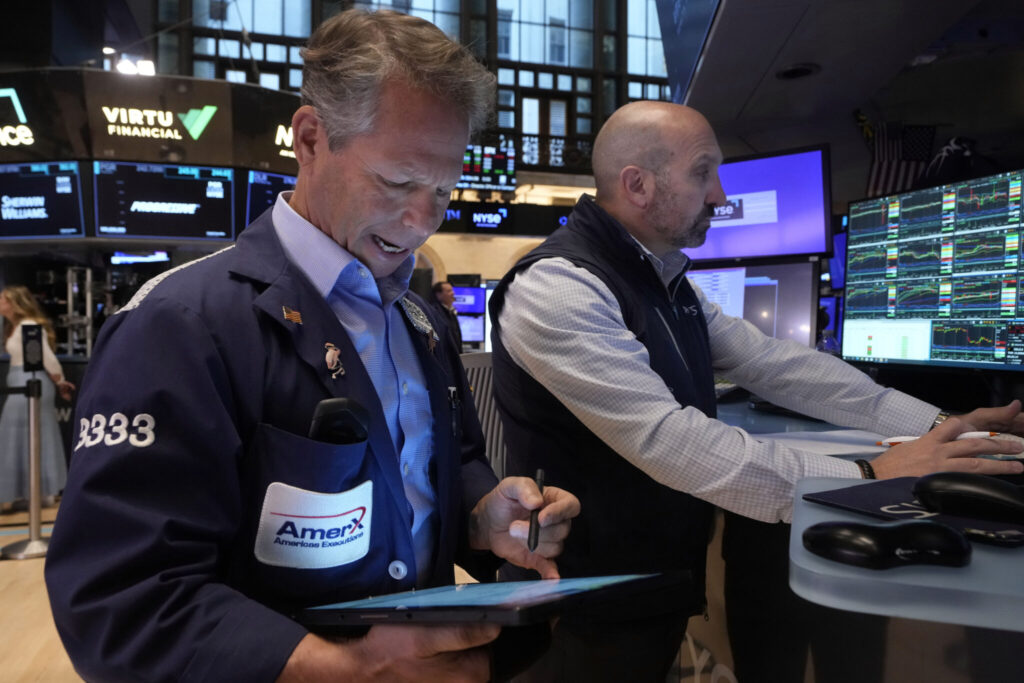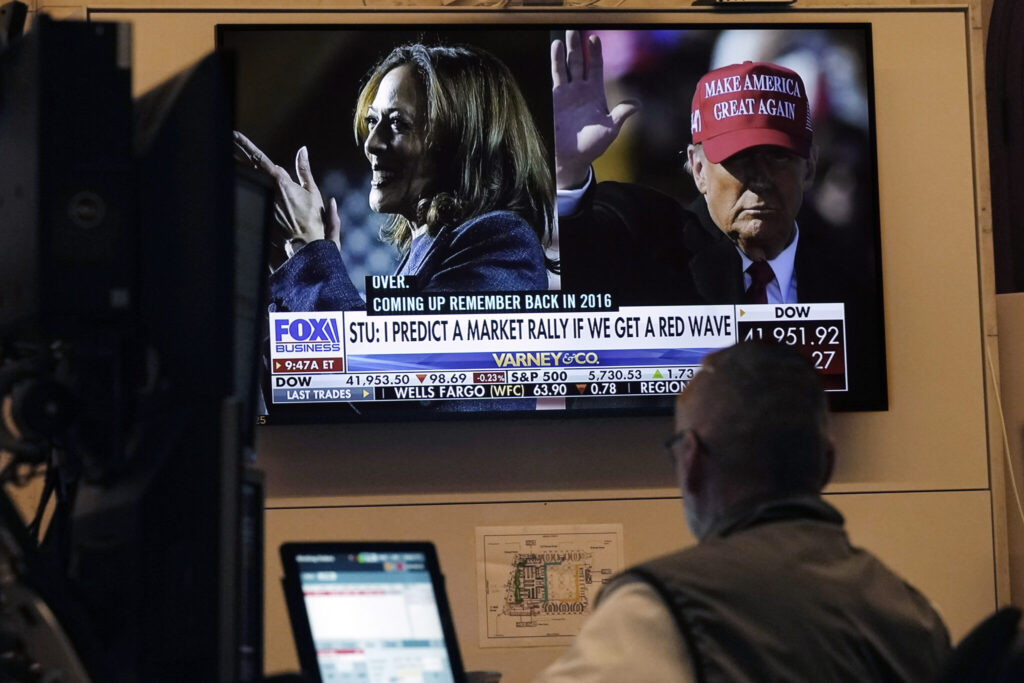Stock market Election Day 2024/ U.S. stocks November 2024/ Wall Street election news/ Federal Reserve rate cut/ oil price increase/ Newslooks/ NEW YORK/ J. Mansour/ Morning Edition/ With Election Day looming, U.S. stocks remain steady as investors brace for potential market shifts. Treasury yields declined and oil prices rose as investors monitor global developments. The Federal Reserve’s expected rate cut and potential election outcomes add to this week’s financial outlook.

Wall Street Activity Ahead of Election Day: Quick Looks
- Stock Market Stability: U.S. stocks show minimal movement; the S&P 500 rises 0.1%.
- Oil Prices Increase: U.S. crude climbs by 2.3% due to delayed output increases from oil exporters.
- Treasury Yields Drop: The 10-year Treasury yield fell to 4.30% amid election uncertainty.
- Global Factors: China’s potential economic measures and Federal Reserve rate cut expected this week.
- Key Stocks in Focus: Nvidia and Sherwin-Williams see gains as they prepare to join the Dow Jones.
Deep Look
As Election Day approaches, U.S. markets are holding steady despite potential volatility on the horizon. By midday on Monday, the S&P 500 had edged up slightly, while the Dow Jones Industrial Average showed a modest decline. The Nasdaq composite saw a similar minor increase as investors looked ahead to a week filled with both market-moving events and global uncertainties.
Key Market Movements
Stocks
The S&P 500 was up by 0.1% as of midday, nearing its all-time high reached last month, while the Dow dropped by 144 points, or 0.3%. The Nasdaq composite rose by 0.3%, continuing its trend of resilience amid uncertainty.
Mixed earnings reports influenced specific stocks. Marriott International fell 2.1% after reporting weaker-than-expected quarterly profits, while Fox Corporation gained 4.4% following a strong earnings report despite rising news coverage costs related to the election cycle.
Oil Prices
In the energy sector, oil prices saw a significant increase. U.S. crude oil rose by 2.3%, reaching $71.12 per barrel, while Brent crude, the global benchmark, climbed by 1.7% to $74.36 per barrel. This price hike followed announcements from Saudi Arabia and other oil-exporting nations delaying planned increases in crude production, causing a ripple effect in the market.
Despite the recent uptick, Brent crude remains down for the year. Part of this decline is attributed to ongoing concerns about demand from China, the world’s second-largest economy, which has been facing challenges, especially in its real-estate sector. However, market analysts anticipate that China’s National People’s Congress may unveil new stimulus measures this week to bolster its economy, which could further impact global oil demand and prices.
Treasury Yields
U.S. Treasury yields declined, with the yield on the 10-year Treasury note dropping from 4.38% on Friday to 4.30%. This dip comes after weeks of rising yields driven by expectations of a stronger economy and speculation over a potential Trump win, which some investors believe could introduce trade tariffs or policies affecting debt and inflation. While Treasury yields previously surged due to robust economic data, this recent decline reflects investors’ caution as Election Day draws near.
Broader Economic Outlook
Election Day Uncertainty
Election Day in the U.S. on Tuesday is a focal point for market observers, although it’s unclear when results will be finalized. Both the 2016 and 2020 elections led to uncertainty in the days following as final tallies took time to complete. Yet despite the potential delay in results, analysts are cautiously optimistic based on historical trends: the U.S. stock market has historically performed well following a presidential election, regardless of the winning party. In 2020, for example, stocks rallied even amidst delayed results and contestation by former President Trump.
According to Morgan Stanley strategist Michael Zezas, the current market activity may have already adjusted to potential election outcomes. For instance, the Mexican peso has seen declines against the U.S. dollar, anticipating the possible imposition of tariffs on Mexican imports if Trump wins. Markets are less likely to react as strongly to a Trump victory this time around than in 2016 when the surprise result led to a surge in Treasury yields as investors expected tax cuts and economic stimulus under his leadership.
Federal Reserve Interest Rate Decision
This week’s Federal Reserve meeting is another key event for investors, with the Fed widely expected to announce a rate cut, marking its second consecutive reduction. In September, the Fed initiated its rate-cutting trend with an aggressive half-percentage-point reduction, a move aimed at supporting a robust labor market. This marks a significant pivot from the Fed’s previous focus on combating inflation through higher rates, reflecting a shift in its approach to sustaining economic growth.
Optimism about these rate cuts has fueled gains in major U.S. stock indexes, with the hope that the economy can dodge a long-anticipated recession. If the Fed’s rate cuts prove effective, they could further sustain market stability in the face of post-election volatility.
Stocks to Watch
Nvidia and Sherwin-Williams
Among individual stocks, Nvidia climbed 2.5%, boosting the S&P 500. Nvidia’s gains come as demand continues to surge for its high-powered chips, which are essential to the development of artificial intelligence technology. Nvidia’s stock strength contributed to its recent inclusion in the Dow Jones Industrial Average, replacing Intel in the index. Sherwin-Williams also rose by 4% following the announcement that it would join the Dow, replacing Dow Inc., the chemical manufacturer.
Trump Media & Technology Group
Trump Media & Technology Group, which manages Trump’s Truth Social platform, showed volatile trading, swinging between losses and gains before settling up 1.4% by late morning. This stock has become something of a barometer for Trump’s perceived election chances, experiencing a recent rally before slipping last week.
International Market Trends
Outside the U.S., international markets have shown mixed performance amid fluctuations in the Asian and European indexes. With various economies still grappling with inflation and demand concerns, particularly in China, global markets remain susceptible to both regional and U.S.-based developments.
Conclusion
As Election Day approaches, U.S. financial markets remain mostly stable despite the potential for major shifts. Key factors to monitor include oil price movements, Treasury yield fluctuations, and sector-specific stock performances, particularly in technology and energy. With the Federal Reserve’s anticipated rate cut and ongoing uncertainty over election results, markets may see more significant movements later in the week. However, historical trends suggest a resilient market outlook as investors navigate these high-stakes events.







